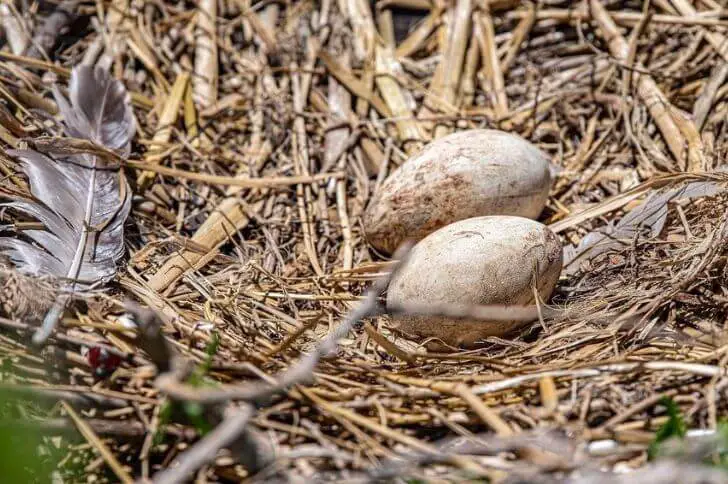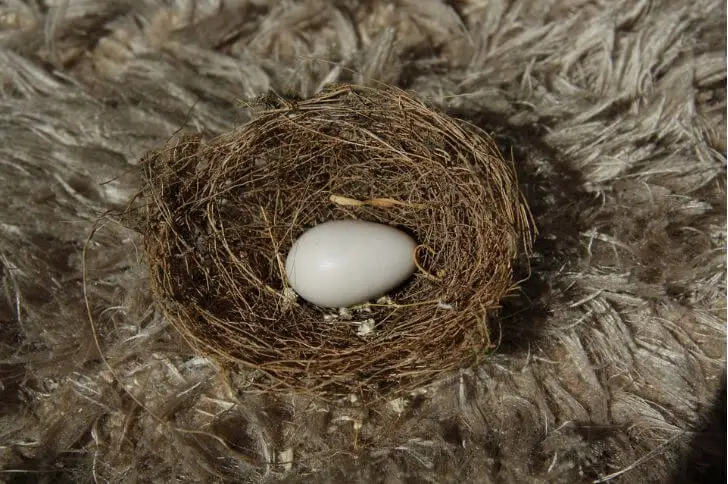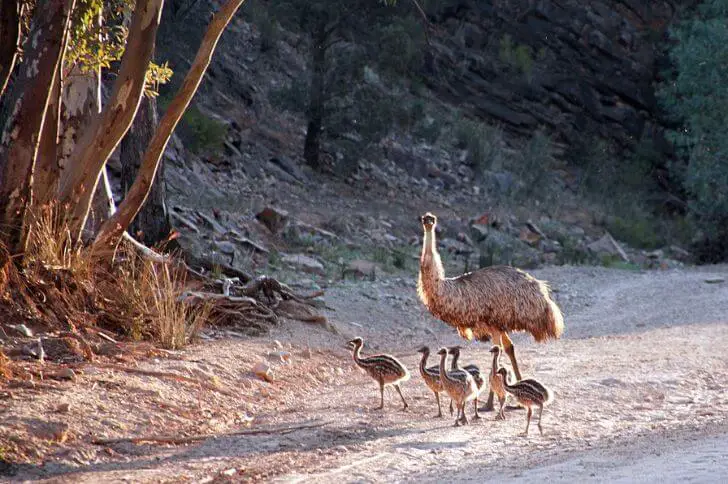Pelican eggs and babies are a wonder of nature. Their eggs are able to withstand the harshest climates and conditions.
Pelican babies are not that cute to look at. But, there is plenty you can learn about these birds at this stage. Below, we’ll explore more about the 7 common types of pelicans, their eggs, babies and other interesting habits. If you are an avid birder, this article has a lot of information that you can add to your birding journal in preparation for your next birding tour.
Pelican Eggs and Babies (Complete Life Cycle)
Nest construction
Once the male pelican has selected a nesting site, it starts a mating ritual dance that is mostly swaying of the head to attract a good mate.
After getting a mate, he will then spend the next 8-10 days gathering large pieces of vegetation, grass and small sticks around the site. The female will then weave into a sturdy platform.
The cup-shaped nest can measure up to 30 inches across and 5 inches deep on the inside.
Brown pelicans eggs

The first bird we’ll look at is the common brown pelican. These North American birds are large, aquatic birds that are found in coastal areas.
They are distinctive for their long, dark necks and yellow heads. How many brown pelicans are there today? According to statistics, brown pelican populations are stable with over 70,000 pairs in the wild.
Where do pelicans lay their eggs?
Brown pelicans lay their eggs in colonies, often on islands or in remote areas. The location must be safe from predators and have easy access to food and water for the chicks.
The female brown pelican weaves the nest from reeds, pebbles, and sticks which the male collects. Occasionally, these birds will roost on bare ground and will pick high sites (3-10 feet high) to protect their eggs.
How many eggs does a brown pelican lay?
Female brown pelicans lay two to four eggs per clutch.
How big is a pelican egg?
How can you identify brown pelican eggs? Usually white in color, brown pelican eggs are about 3 inches and 2 inches wide. The chalky white eggs are about the same size as chicken eggs. During the incubation period, they’ll gradually change color from white to have a stained look.
How long do pelicans sit on their eggs?
Brown pelicans are one of the longest sitting bird species when it comes to incubating their eggs. They can sit on their eggs for up to 30 days.
During this time, they will molt their feathers so that they are not using any energy to keep them clean and in good condition. Pelican parents also take turns sitting on the eggs so that each one gets a chance to eat and rest. They use their webbed feet to keep eggs in place.
Related Read: Learn about birds that lay speckled eggs
What color are pelican babies?

After 28-30 days, the eggs hatch to reveal pink skin, 0.13 lb baby. Pelican babies have their eyes opened and are helpless. After about 2 weeks, you’ll notice the chicks turning black or gray after which they’ll start growing their white, gray-black coat. The beak grows in size as the baby grows.
What do baby pelicans eat?
When brown baby pelicans are first hatched, they are fed a diet of fish oil and fish meal. This helps them to grow quickly. Once they are a little older, they will start to eat small fish like anchovies and sardines. Baby pelicans also love to eat crustaceans, such as crabs and shrimp.
You can easily find brown pelicans in Southern California. Their breeding season occurs in March and April.
American white pelicans
All-white with a long orange-yellow bill, the American white pelican is a large bird that boasts of a 9-foot wingspan. They range from Alberta, to Northern eastern California to Florida and are known for their unique breeding habits.
Where do white pelicans lay their eggs?
Like the brown pelicans, American white pelicans make their nests on shallow depressions. Both sexes take the task of building the nest from reeds, sticks, and twigs. Nests are about 2-inch deep.
How can you identify white pelican eggs? Like other birds in their family, females lay two to three eggs on the tree nests which are about 3.5 inches long. They get discolored during the incubation period.
White pelicans sit on their eggs for about one month. After hatching, american white pelican baby has an orange-colored body with a whitish bill.
These pelican babies feed on fish but will also take salamanders and crayfish.
Great white pelican

Not to be confused with the American white pelican, the great white pelican is an Afroasia bird. They are the same size as the birds above, with their wingspan ranging from 7-11 feet. Now let’s learn about their eggs and babies.
The breeding season of the great white pelican bird lasts from February to May or all-year round depending on the region.
What color are great white pelican eggs? These seabirds lay two-three, sometimes 4 creamish eggs that will turn brownish. Hatching happens after 29-35 days. The great white pelican baby is naked and within a few days you’ll notice it turning to brownish-black.
The chicks fledge after 65-75 days and will attain sexual maturity at age 3-4 years.
Other pelicans
Australian pelican
Is there a pelican in Australia? In the coastal waters of Australia, you’ll find a large 5.3-6 ft black and white bird with a large pinkish bill; the Australian pelican. With a wingspan of up to 11 feet, these birds are known for their swimming ability.
How big is the Australian pelican egg? These birds will build nests on shallow depressions where they lay 3.7 inch long whitish eggs. They are about 2 inches wide, slightly bigger than a chicken egg.
Like other seabirds, they nest in large colonies with both parents caring for the eggs. Incubation lasts for 32-35 days with chicks fledging after three months.
Australian pelican babies will feed macerated food from the throat pouch of their mom or dad.
Dalmatian pelican
Why are they called dalmatian pelicans? It’s not clear how these birds got their names. They do not have other similar coloring to other Dalmatian animals. They are all white with curly feathers and are often mistaken for the great white pelican.
Dalmatian pelicans are monogamous but it’s worth noting the relationship lasts only through the breeding season. Next breeding season they’ll look for another mate.
Like other pelicans, they lay white 3-inch eggs that are incubated on shallow nests for up to 35 days. Like other baby pelicans, the dalmatian babies are naked, helpless with eyes wide open. Their parents feed them with mullet, catfish and eels. They have a higher survival rate compared to other pelican babies.
Peruvian pelican
Peruvian pelicans or the Pelecanus thagus are large 11-15 lb birds that are endemic to part of South America. The birds are dark with long bills and prefer nesting in shallow waters.
How can you identify a Peruvian pelican egg? Nesting seasons begin in September through March. The females lay 2-3 eggs that are whitish and are incubated for 4-5 eggs. The babies are grayish during their first week of life then at about 10 days you’ll notice down feathers on its body. Chicks are fed with different types of fish species.
Pink backed pelican
Where can you find pink backed pelicans? These birds are resident breeders in some parts of Africa. They are smaller than the other pelicans on this list, about 50-61 inches. It’s mostly white and gray. Note the pink hue on its back.
These birds mate all year round and build nests near shallow water where they build their nests at least 160 feet off the ground. They lay 2-3 white eggs that take a few weeks to hatch. Chick feed regurgitated fish from the adult’s pouch.
Also read: Facts about kiwi eggs
FAQs
Where do pelicans nest at night?
There are many different places where pelicans nest. Some pelicans nest in colonies, while others nest alone. Pelican colonies can be found on small islands and coastal wetlands. They build their nests out of sticks, reeds and grasses, and lay two or three eggs. The nest are large measuring about 30 inches across and 4 inches deep.
Where can I find pelicans?
Brown pelicans can be found in Texas particularly in Pelican Island while American white pelicans can be found in the Pacific coast. Other pelicans can be found in the Caribbean coasts and parts of Africa.
Why do you never see pelican babies?
The average pelican lays two eggs, but you never see the baby pelicans. Pelican babies are very small and featherless and are not able to fly for the first few weeks of their lives. They stay in the nest until they are about six weeks old, being fed by their parents. Then they can fly and join their parents on their fishing trips.
How do pelicans reproduce?
Pelicans are monogamous but unlike other species they do not mate for life. Pairs will only remain together for the incubation period and when raising their young. A male, especially brown pelicans, performs various stunts to attract the female.
What do you call a baby pelican?
There are many different names for baby pelicans. Some of the most common include hatchling, chick, nestling, and fledging. Baby pelicans are typically born in late spring or early summer. They are very vulnerable at this stage and need their parents to protect them from predators.
Can pelicans eat humans?
No, they don’t eat humans.
Where do baby pelicans live?
Most baby pelicans live in colonies with their parents along the coast. They live in nests that their parents build on the ground or in trees. The nests are made of sticks, grass, and other materials. It may be hard to spot them because the nests are built high above.
How many babies do pelicans have?
Pelicans are a type of bird that is found in many parts of the world. They are known for their large size and their long beaks. Pelicans typically have two or three babies at a time. In some regions mating takes place all year round but all birds in the pelican family raise two to three babies yearly.
Do pelicans mate for life?
A monogamous bird, the pelican does not mate for life. Pelicans especially the brown pelicans and American white pelicans will change the mate yearly or after a few year. And they remain loyal to their partner when they are together.
Do pelicans eat their babies?
Yes, pelicans do sometimes eat their young. Pelicans are known for being very protective of their young, but there are times when they will actually eat them. This usually happens when there is not enough food available to support all of the birds in the nest, and the parents will have to make a tough decision about which chicks to feed and which ones to let starve.
Although it is heartbreaking for us to see, this is just a natural part of life for pelicans. They are able to produce more offspring than they can actually take care of, so some chicks will inevitably die. Pelican species that eat their young include brown, Peruvian, and Australian pelicans.
Do pelicans live in family groups?
Pelicans are highly social animals and typically live in colonies of anywhere from a few dozen to several thousand birds. Family units exist with these colonies. You’ll find groups of pelicans in islands and coastal waters.
How do pelicans feed their babies
Pelicans are large, aquatic birds that feed their young with fish. The parent will regurgitate the food and keep it in a pouch on the underside of their beak. The chicks will then eat directly from the throat pouch. Pelican parents will take turns feeding their young.
Will a pelican bite you?
While pelicans are not typically aggressive birds, they can bite if threatened or harassed. The edges of their bills are strong and sharp enough to pierce the scales of fish, making them capable of delivering a painful bite to humans.
Where do pelicans live
Pelicans are a large, aquatic bird that can be found in many parts of the world. They typically live near water, and can be found in both coastal and inland areas. In the United States you can find them in the Pacific coasts, gulf coast, Australia, and Asia.
Final thought:
Are pelicans endangered? Currently the populations around the world are stable. And there are bird conservation measures in place to ensure populations remain stable.
Pelican eggs are almost the same size and color across the different living species. Pelican babies are normally small and naked. They do not fly and rely on their parents during the first few weeks of their lives.
Hi, my name is Steve. My friend and I started the spanishbirdguides.com to share our passion with other like-minded people. So, if bird watching is your thing, you’ll love this blog. I’ll share what I’ve learnt about both local birds and those found in other parts of the world. Also, I’d love to hear your experiences.



